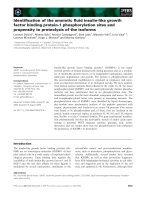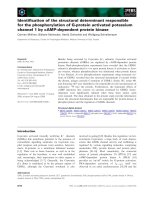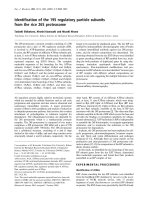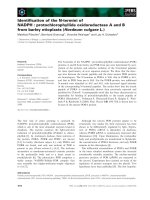Báo cáo toán học: "Unification of the Quintuple and Septuple Product Identities" pps
Bạn đang xem bản rút gọn của tài liệu. Xem và tải ngay bản đầy đủ của tài liệu tại đây (106.5 KB, 10 trang )
Unification of the Quintuple
and Septuple Product Identities
Wenchang Chu and Qinglun Yan
∗
Department of Applied Mathematics
Dalian University of Technology
Dalian 116024, P. R. China
Submitted: Jun 26, 2006; Accepted: Mar 20, 2007; Published: Mar 28, 2007
Mathematics Subject Classifications: 05A30, 14K25
Abstract
By combining the functional equation method with Jacobi’s triple product iden-
tity, we establish a general equation with five free parameters on the modified Jacobi
theta function, which can be considered as the common generalization of the quintu-
ple, sextuple and septuple product identities. Several known theta function formulae
and new identities are consequently proved.
1 Introduction and Notation
For two indeterminate q and x with |q| < 1, the q-shifted factorial of infinite order reads
as
(x; q)
∞
=
∞
i=0
(1 − xq
i
) = (1 − x)(1 − qx)(1 − qx
2
) · · · .
Then we define the modified Jacobi theta function by
x; q
∞
= (q; q)
∞
(x; q)
∞
(q/x; q)
∞
.
∗
Email addresses: and
the electronic journal of combinatorics 14 (2007), #N7 1
Their product forms are abbreviated respectively as
(α, β, · · · , γ; q)
∞
= (α; q)
∞
(β; q)
∞
· · · (γ; q)
∞
,
α, β, · · · , γ; q
∞
= α; q
∞
β; q
∞
· · · γ; q
∞
.
There are several important theta function identities in mathematical literature. Perhaps
the simplest and the most significant one is Jacobi’s triple product identity [23] (see [18,
§1.6] also):
x; q
∞
=
+∞
n=−∞
(−1)
n
q
(
n
2
)
x
n
.
For different proofs and applications, we refer the reader to the papers by Andrews [2],
Chu [8], Ewell [10], Lewis [25], Mordell [27] and Wright [33]. The next one is the celebrated
quintuple product identity attributed originally to Watson [32]. However, it can also be
found in Ramanujan’s lost notebook, which has been cleared by Berndt [4, P 83]. Later
in 1995, Ewell [11] found a sextuple product identity, which has both beautiful form
and interesting applications to congruences of partition function (see Ewell [12, 13, 14]).
Hirschhorn [21] found, first in 1983, the septuple product identity, which was subsequently
rediscovered by Farkas and Kra [15] in 1999. More recently, Chapman [6], Foata-Han [16],
Garvan [17] and Kongsirwong-Liu [24] provided different proofs. From algebraic point of
view, some identities just mentioned can be recovered from the identities for affine root
systems due to Macdonald [26] such as the quintuple product identity (from BC
1
) and
the septuple product identity (from BC
2
), as observed in [29, §6].
The purpose of the present paper is to unify all the identities just mentioned into a
single formula. By means of the functional equation method and Jacobi’s triple product
identity, we shall show a general equation on the modified Jacobi theta function which
covers several known and new theta function identities. The main theorem and its proof
will be given in the next section. As applications, we shall systematically review the known
identities such as the quintuple, sextuple and septuple products and establish several new
theta function identities through Section 3 to 5 in the rest of the paper.
2 Main Theorem and Proof
By combining the functional equations with Jacobi’s triple product identity, we prove the
following fundamental result.
Theorem 1. Let α, β and γ be three natural integers with gcd(α, γ) = 1 and λ = 1+αβ
2
γ.
the electronic journal of combinatorics 14 (2007), #N7 2
For two indeterminate x and y with x = 0 and y = 0, there holds the algebraic identity:
x; q
α
∞
x
βγ
y; q
γ
∞
=
αβ
2
γ
=0
(−1)
q
(
2
)
α
x
(−1)
αβ
x
λ
y
αβ
q
(
αβ
2
)
γ+α
; q
λα
∞
×
(−1)
βγ
y q
(
βγ+1
2
)
α−αβγ
; q
λγ
∞
.
Proof. For the bivariate function f(x, y) defined by the infinite product
f(x, y) = x; q
α
∞
x
βγ
y; q
γ
∞
it is easy to see that f(x, y) is analytic within 0 < |x| < ∞. Then we can expand it as a
Laurent series in x:
f(x, y) =
+∞
k=−∞
Ω
k
(y)x
k
.
From the definition of f(x, y), it is trivial to check the functional equation
f(x, y) = (−1)
1+αβ
q
(
αβ
2
)
γ
x
λ
y
αβ
f(q
α
x, y),
which corresponds to the recurrence relation
Ω
k
(y) = (−1)
1+αβ
y
αβ
q
(k−λ)α+
(
αβ
2
)
γ
Ω
k−λ
(y).
Iterating this relation for k-times, we find that there exist λ = 1 + αβ
2
γ formal power
series Ω
(y) with 0 ≤ ≤ αβ
2
γ such that there hold
Ω
kλ+
(y) = (−1)
k+kαβ
y
kαβ
q
λ
(
k
2
)
α+k
(
αβ
2
)
γ+kα
Ω
(y) where k ∈ Z.
By invoking Jacobi’s triple product identity, we can also expand f(x, y) directly into the
following double series:
f(x, y) =
+∞
i=−∞
+∞
j=−∞
(−1)
i+j
q
(
i
2
)
α+
(
j
2
)
γ
x
i+jβγ
y
j
.
Equating the coefficients of x
in the two formal power series expansions of f(x, y), we
find that
Ω
(y) =
+∞
j=−∞
(−1)
j++jβγ
y
j
q
(
−jβγ
2
)
α+
(
j
2
)
γ
= (−1)
q
(
2
)
α
+∞
j=−∞
(−1)
j+jβγ
y
j
q
λ
(
j
2
)
γ+j
(
βγ+1
2
)
α−jαβγ
.
the electronic journal of combinatorics 14 (2007), #N7 3
Therefore, f (x, y) can be reformulated as
f(x, y) =
αβ
2
γ
=0
+∞
k=−∞
Ω
kλ+
(y)x
kλ+
=
αβ
2
γ
=0
(−1)
q
(
2
)
α
x
×
+∞
k=−∞
(−1)
k+kαβ
x
kλ
y
kαβ
q
λ
(
k
2
)
α+k
(
αβ
2
)
γ+kα
×
+∞
j=−∞
(−1)
j+jβγ
y
j
q
λ
(
j
2
)
γ+j
(
βγ+1
2
)
α−jαβγ
.
Applying twice Jacobi’s triple product identity to the double sum just displayed, we
establish the equation stated in the theorem.
The simplest case α = β = γ = 1 of Theorem 1 reads as the following sextuple product
identity, essentially discovered by Ewell [11, 12, 14].
Corollary 2 (The sextuple product identity).
x, xy; q
∞
=
−qy, −x
2
y; q
2
∞
− x
−y, −qx
2
y; q
2
∞
.
In fact, making the parameter replacements q → q
2
, x → −qxy and y → 1/y
2
and then
applying Jacobi’s triple product identity, we see that the last equation is equivalent to
the sextuple product identity due to Ewell [12, Eq 2.2]:
−qxy, −qx/y; q
2
∞
=
+∞
i=−∞
q
2i
2
x
2i
+∞
j=−∞
q
2j
2
y
2j
+ q
+∞
i=−∞
q
2i(i+1)
x
2i+1
+∞
j=−∞
q
2j(j+1)
y
2j+1
.
If we let q → q
2
, x → −q and y → 1 in Corollary 2, then we can get immediately another
identity due to Ewell [13, Thm 2.1]:
∞
n=1
(1 − q
4n−2
)
2
(1 + q
2n−1
)
4
=
∞
n=1
(1 + q
4n−2
)
4
+ 4q
∞
n=1
(1 + q
4n
)
4
.
For more applications of the sextuple product identity, the interested reader may consult
Ewell [11, 12, 13, 14].
the electronic journal of combinatorics 14 (2007), #N7 4
3 The Quintuple Product Identities
This section reviews the application of Theorem 1 to quintuple product identities. We
first state the case β = 1 of Theorem 1 as follows.
Proposition 3. Let α and γ be two natural integers with gcd(α, γ) = 1. For two inde-
terminate x and y with x = 0 and y = 0, there holds the algebraic identity:
x; q
α
∞
x
γ
y; q
γ
∞
=
αγ
=0
(−1)
q
(
2
)
α
x
(−1)
α
x
1+αγ
y
α
q
(
α
2
)
γ+α
; q
α(1+αγ)
∞
×
(−1)
γ
y q
(
γ+1
2
)
α−αγ
; q
γ(1+αγ)
∞
.
When α = 2 and γ = 1, we find from Proposition 3 the following generalized quintuple
product identity.
Corollary 4.
x; q
∞
xy; q
2
∞
=
−qy; q
3
∞
+∞
i=−∞
(−1)
i
q
3i
2
−2i
x
3i
y
i
−
−q
3
y; q
3
∞
+∞
i=−∞
(−1)
i
q
3i
2
x
3i+1
y
i+1
+
−q
2
y; q
3
∞
+∞
i=−∞
(−1)
i
q
3i
2
+2i
x
3i+2
y
i+1
.
Instead, when α = 1 and γ = 2, we recover from Proposition 3 another generalized
quintuple product identity.
Corollary 5 (Hirschhorn [22, Eq 2]).
x; q
∞
x
2
y; q
2
∞
=
q
3
y; q
6
∞
+∞
i=−∞
q
3
(
i
2
)
x
3i
y
i
−
qy; q
6
∞
+∞
i=−∞
q
3
(
i
2
)
+i
x
3i+1
y
i
−
q
5
y; q
6
∞
+∞
i=−∞
q
3
(
i
2
)
+2i
x
3i+2
y
i+1
.
We remark that under the parameter replacement y → xy, the left member displayed in
Corollary 4 becomes that in Corollary 5. However the corresponding right members are
not euqivalent.
the electronic journal of combinatorics 14 (2007), #N7 5
For x → −qx and y → −q
−1
, Corollary 5 reduces to the following identity due to Stan-
ton [30, 1986], who derived it through sign variations of the Macdonald identities.
Example 6 (Stanton [30]).
−qx; q
∞
−qx
2
; q
2
∞
=
−1; q
6
∞
+∞
i=−∞
q
3
(
i
2
)
+3i+1
x
3i+1
+
−q
2
; q
6
∞
+∞
i=−∞
q
3
(
i
2
)
+2i
1 + q
2i+1
x
2
x
3i
.
Letting y = 1 and y = q in Corollary 5, we further get respectively the following two
quintuple product identities.
Example 7.
x; q
∞
x
2
; q
2
∞
=
q
3
; q
6
∞
+∞
i=−∞
q
3
(
i
2
)
x
3i
−
q; q
6
∞
+∞
i=−∞
q
3
(
i
2
)
+i
1 + q
i
x
x
3i+1
.
Example 8 (The quintuple product identity).
x; q
∞
qx
2
; q
2
∞
= (q
2
; q
2
)
∞
+∞
i=−∞
q
3
(
i
2
)
+i
(1 − xq
i
)x
3i
.
The last one is the so-called quintuple product identity. For the historical note, different
proofs and extensions about this celebrated identity, the reader can refer to [1, 3, 5, 19,
22, 31]. A comprehensive bibliography for the proofs of this identity is given in Cooper’s
survey paper [9]. In addition, Paule [28] found a finite form of the quintuple product
identity. Two further finite forms have been given in the recent papers [7] and [20].
4 The Septuple Product Identities
In order to derive the generalized septuple product identities, we state first the case β = 2
of Theorem 1 as follows.
the electronic journal of combinatorics 14 (2007), #N7 6
Proposition 9. Let α and γ be two natural integers with gcd(α, γ) = 1. For two inde-
terminate x and y with x = 0 and y = 0, there holds the algebraic identity:
x; q
α
∞
x
2γ
y; q
γ
∞
=
4αγ
=0
(−1)
q
(
2
)
α
x
x
1+4αγ
y
2α
q
(
2α
2
)
γ+α
; q
α(1+4αγ)
∞
×
y q
(
2γ+1
2
)
α−2αγ
; q
γ(1+4αγ)
∞
.
When α = γ = 1, replacing q by q
2
in Proposition 9 leads to the following generalized
septuple product identity.
Corollary 10.
x, x
2
y; q
2
∞
=
q
6
y; q
10
∞
+∞
i=−∞
(−1)
i
q
5i
2
−3i
x
5i
y
2i
−
q
2
y; q
10
∞
+∞
i=−∞
(−1)
i
q
5i
2
−i
x
5i+1
y
2i
−
q
8
y; q
10
∞
+∞
i=−∞
(−1)
i
q
5i
2
+i
x
5i+2
y
2i+1
+
q
4
y; q
10
∞
+∞
i=−∞
(−1)
i
q
5i
2
+3i
x
5i+3
y
2i+1
−
y; q
10
∞
+∞
i=−∞
(−1)
i
q
5i
2
+5i+2
x
5i+4
y
2i+1
.
The two particular cases of interest may be displayed as follows.
Example 11 (The septuple product identity: x → x and y → 1 in Corollary 10).
x, x
2
; q
2
∞
=
q
4
; q
10
∞
+∞
i=−∞
(−1)
i
q
5i
2
−3i
1 + q
6i
x
3
x
5i
−
q
2
; q
10
∞
+∞
i=−∞
(−1)
i
q
5i
2
−i
1 + q
2i
x
x
5i+1
.
We point out that this septuple product identity first appeared in Hirschhorn [21] explic-
itly, even though it has been attributed erroneously to Farkas-Kra [15] by Foata-Han [16,
Eq 1.6] and Chapman [6, Thm 1].
the electronic journal of combinatorics 14 (2007), #N7 7
Example 12 (Kongsiriwong-Liu [24, Eq 7.36]: x → qx and y → q
−1
in Corol-
lary 10).
qx, qx
2
; q
2
∞
=
q
5
; q
10
∞
+∞
i=−∞
(−1)
i
q
5i
2
x
5i
−
q; q
10
∞
+∞
i=−∞
(−1)
i
q
5i
2
+2i+1
1 − q
6i+3
x
3
x
5i+1
−
q
3
; q
10
∞
+∞
i=−∞
(−1)
i
q
5i
2
+4i+1
1 − q
2i+1
x
x
5i+2
.
5 Further Theta Function Identities
For the presence of five free parameters, we may further specialize Theorem 1 to nu-
merous theta function identities. Leaving the parameter γ invariant, this section col-
lects four theta function identities, just for examples, which have appeared previously in
Kongsiriwong-Liu [24]. Here all the parameter settings refer to Theorem 1 under the same
base substitution q → q
2
.
Example 13 ([24, Thm 6]: α = 1 and β = 1: x → qx and y → q
−γ
).
qx; q
2
∞
x
γ
; q
2γ
∞
=
γ
=0
(−1)
q
2
+∞
i=−∞
(−1)
(γ+1)i
q
(γ
2
+γ)i
2
−(2+1)γi
×
+∞
j=−∞
q
(γ+1)j
2
+(2−γ)j
x
(γ+1)j+
.
Example 14 ([24, Thm 7]: α = 1 and β = 1: x → qx and y → 1).
qx; q
2
∞
q
γ
x
γ
; q
2γ
∞
=
γ
=0
(−1)
q
2
+∞
i=−∞
(−1)
(γ+1)i
q
(γ
2
+γ)i
2
−2γi
×
+∞
j=−∞
q
(γ+1)j
2
+2j
x
(γ+1)j+
.
Example 15 ([24, Thm 8]: α = 1 and β = 2: x → x and y → 1).
x; q
2
∞
x
2γ
; q
2γ
∞
=
4γ
=0
(−1)
q
2
−
+∞
i=−∞
(−1)
i
q
(4γ
2
+γ)i
2
+(1−4)γi
×
+∞
j=−∞
(−1)
j
q
(4γ+1)j
2
+(2−2γ−1)j
x
(4γ+1)j+
.
the electronic journal of combinatorics 14 (2007), #N7 8
Example 16 ([24, Thm 9]: α = 1 and β = 2: x → qx and y → q
−γ
).
qx; q
2
∞
q
γ
x
2γ
; q
2γ
∞
=
4γ
=0
(−1)
q
2
+∞
i=−∞
(−1)
i
q
(4γ
2
+γ)i
2
−4γi
×
+∞
j=−∞
(−1)
j
q
(4γ+1)j
2
+2j
x
(4γ+1)j+
.
References
[1] K. Alladi, The quintuple product identity and shifted partition functions, J. Comput.
Appl. Math. 68 (1996), 3-13.
[2] G. E. Andrews, A simple proof of Jacobi’s triple product identity, Proc. Amer. Math.
Soc. 16 (1965), 333-334.
[3] A. O. L. Atkin and P. Swinnerton-Dyer, Some properties of partitions, Proc. London
Math. Soc. 4 (1954), 84-106.
[4] B. C. Berndt, Ramanujan’s Notebooks, Part III, Springer-Verlag, New York, 1991.
[5] L. Carlitz and M. V. Subbarao, A simple proof of the quintuple product identity, Proc.
Amer. Math. Soc. 32:1 (1972), 42-44.
[6] R. Chapman, On a septuple product identity, The Andrews Festschrift (Maratea,
1998); Actes 42
e
S´eminaire Lotharingien de Combinatoire 43 (1999), 1-4.
[7] W. Y. C. Chen, W. Chu and N. S. S. Gu, Finite form of the quintuple product
identity, J. Combin. Theory (Ser. A) 113:1 (2006), 185-187.
[8] W. Chu, Durfee rectangles and the Jacobi triple product identity, Acta Math. Sinica
(New Series) 9:1 (1993), 24-26.
[9] S. Cooper, The quintuple product identity, International Journal of Number Theory
2:1 (2006), 115-161.
[10] J. A. Ewell, An easy proof of the triple-product identity, Amer. Math. Monthly 88
(1981), 270-272.
[11] J. A. Ewell, Arithmetical consequences of a sextuple product identity, Rocky Mountain
J. Math. 25 (1995), 1287-1293.
[12] J. A. Ewell, On an identity of a Ramanujan, Proc. Amer. Math. Soc. 125 (1997),
3769-3771.
[13] J. A. Ewell, A note on a Jacobian identity, Proc. Amer. Math. Soc. 126 (1998), 421-
423.
[14] J. A. Ewell, Further consequences of a sextuple product identity, Rocky Mountain J.
Math. 32 (2002), 123-128.
[15] H. M. Farkas and I. Kra, On the quintuple product identity, Proc. Amer. Math.
Soc. 127:3 (1999), 771-778.
the electronic journal of combinatorics 14 (2007), #N7 9
[16] D. Foata and G. N. Han, The triple, quintuple and septuple product identities revis-
ited, The Andrews Festschrift (Maratea, 1998); Actes 42
e
S´eminaire Lotharingien
de Combinatoire 42 (1999), 1-12.
[17] F. G. Garvan, A generalization of the Hirschhorn-Farkas-Kra septagonal numbers
identity, Discrete math. 232 (2001), 113-118 .
[18] G. Gasper and M. Rahman, Basic Hypergeometric Series (2nd edition), Cambridge
University Press, 2004.
[19] B. Gordon, Some identities in combinatorial analysis, Quart. J. Math. (Oxford) 12
(1961), 285-290.
[20] V. J. W. Guo and J. Zeng, Short proofs of summation and transformation formulas
for basic hypergeometric series, J. Math. Anal. Appl. 327:1 (2007), 310-325.
[21] M. D. Hirschhorn, A simiple proof of an identity of Ramanujan, J. Austral. Math.
Soc. (Ser. A) 34 (1983), 31-35.
[22] M. D. Hirschhorn, A generalisation of the quintuple product identity, J. Austral.
Math. Soc. (Ser. A) 44 (1988), 42-45.
[23] C. G. J. Jacobi, Fundamenta Nova Theoriae Functionum Ellipticarum, Fratrum
Borntr¨ager Regiomonti, 1829; Gesammelte werke, Erster Band, G. Reimer, Berlin,
1881.
[24] S. Kongsiriwong and Z. G. Liu, Uniform proofs of q-series-product identities, Results
in Math. 44 (2003), 312-339. .
[25] R. P. Lewis, A combinatorial proof of the triple product identity, Amer. Math.
Monthly 91 (1984), 420-423.
[26] I. G. Macdonald, Affine root systems and Dedekinds η-function, Invent. Math. 15
(1972), 91-143.
[27] L. J. Mordell, An identity in combinatorial analysis, Proc. Glasgow Math. Ass. 5
(1961), 197-200.
[28] P. Paule, Short and easy computer proofs of the Rogers-Ramanujan identities and of
identities of similar type, Electron. J. Combin. 1 (1994), R#10.
[29] H. Rosengren and M. Schlosser, Elliptic determinant evaluations and the Macdonald
identities for affine root systems, Compositio Math. 142 (2006), 937-961.
[30] D. Stanton, Sign variations of the Macdonald identities, SIAM. J. Math. Annal.
17(1986), 1454-1460.
[31] M. V. Subbarao and M. Vidyasagar, On Watson’s quintuple product identity, Proc.
Amer. Math. Soc. 26:1 (1970), 23-27.
[32] G. N. Watson, Theorems stated by Ramanujan VII: Theorems on continued frac-
tions, J. London Math. Soc. 4 (1929), 39-48.
[33] E. M. Wright, An enumerative proof of an identity of Jacobi, J. London Math. Soc. 40
(1965), 55-57.
the electronic journal of combinatorics 14 (2007), #N7 10









